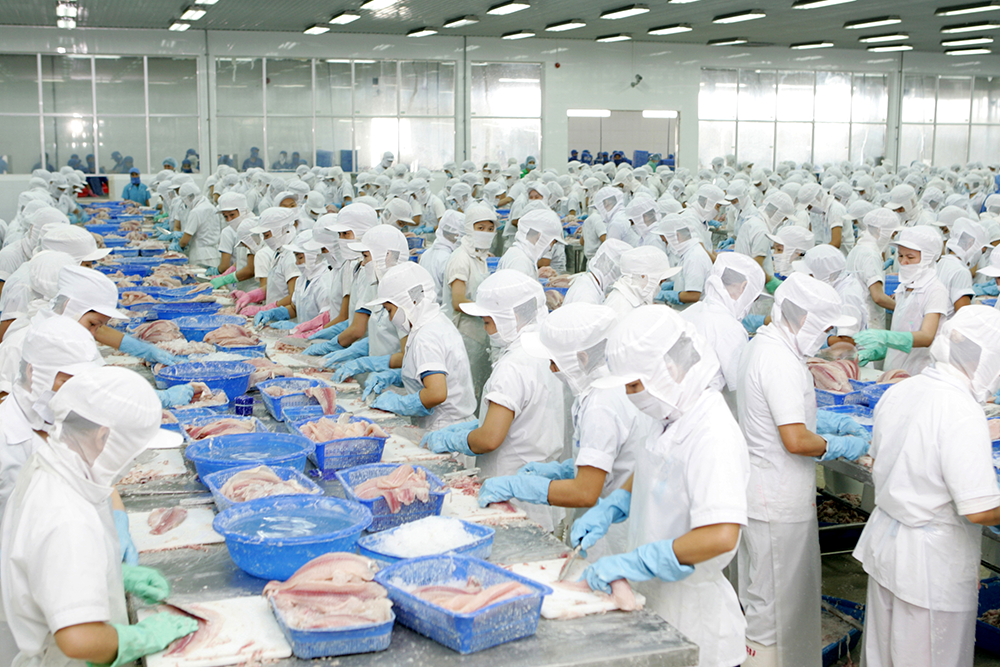According to the Vietnam Pangasius Association, in early 2020, the evolution of the COVID-19 epidemic had an impact on the production, processing and export of Vietnam pangasius industry.
In the first months of 2020, the COVID-19 epidemic has been complicated and outbreaks have occurred in many countries such as China, United States and countries in the EU. These are the major and key markets for Vietnam’s pangasius export.
Seafood export turnover of Vietnam in the first 3 months of 2020 to major markets has sharply decreased compared to the same period in 2019. Specifically, to China decreased by 48%, to the EU decreased by 47.3%, to United States decreased by 19.8%.
Mr. Tran Dinh Luan – General Director of the General Department of Fisheries – said that China is now under control and the trade is starting to recover. Moreover, inventories in some major importing countries are currently at low levels.
It is forecasted that the pangasius industry is likely to recover completely from the third quarter of 2020, and the Chinese market may recover by the end of May 2020, so a production adjustment scenario is needed to avoid shortages of raw materials for processing and export.
In order for the fish industry to develop sustainably and to respond to the current opportunities and challenges, Vietnam needs to focus on building a product line of high quality pangasius fillet; diversify products, develop value-added product lines; promoting competition and restructuring Pangasius industry; improve product quality, build image and brand Vietnam Pangasius.
At the same time, focusing on developing domestic consumption markets such as working with supermarkets, domestic distribution systems to boost domestic consumption of pangasius, not to be dependent on, pressure on export markets, and boosting pangasius export to markets that initially curbed the COVID-19 epidemic such as China, Europe, Japan, ASEAN … and potential large markets such as the US, Russia, Brazil…
India is considered a potential market of Vietnam pangasius industry. The population of India is currently over 1.3 billion and it is expected to become the highest population country in the world by 2027. India’s pangasius farming production reached 0.85 million tons in 2018, but the yellow flesh of the fish and processing plants in this country have not produced white meat Pangasius fillet products and food hygiene and safety as in Vietnam. At the moment, Vietnamese pangasius fillet products are considered as high-class products being imported to serve in restaurants in India.
On Feb 12, 2020, the EVFTA Agreement was officially ratified by the European Parliament. It is expected that in May 2020, it will be passed by the National Assembly of Vietnam and can take effect in July 2020. From there, opening up new opportunities for pangasius exporters to take advantage of businesses need to be prepared before the tax rate of pangasius go down to 0% in the next 3 years.
The present time is assessed not only to open up opportunities for Vietnamese pangasius manufacturers to overcome challenges but also to provide opportunities for importers in the US and EU markets to buy pangasius at a good price when the major import market of Vietnamese pangasius, China, is being interrupted.

More than 40 years of experience in seafood processing and export, and with the achievements, Hung Hau Agriculture Joint Stock Company (HungHau Holdings’ Agriculture division) is proud to be one of the pioneering companies to offer to the market with high quality products processed from seafood. With a team of experienced engineers, workers and factories with modern equipment, it is the right time for the company to seize and take advantage of opportunities to bring its products closer to the consumers.



 Tiếng Việt
Tiếng Việt